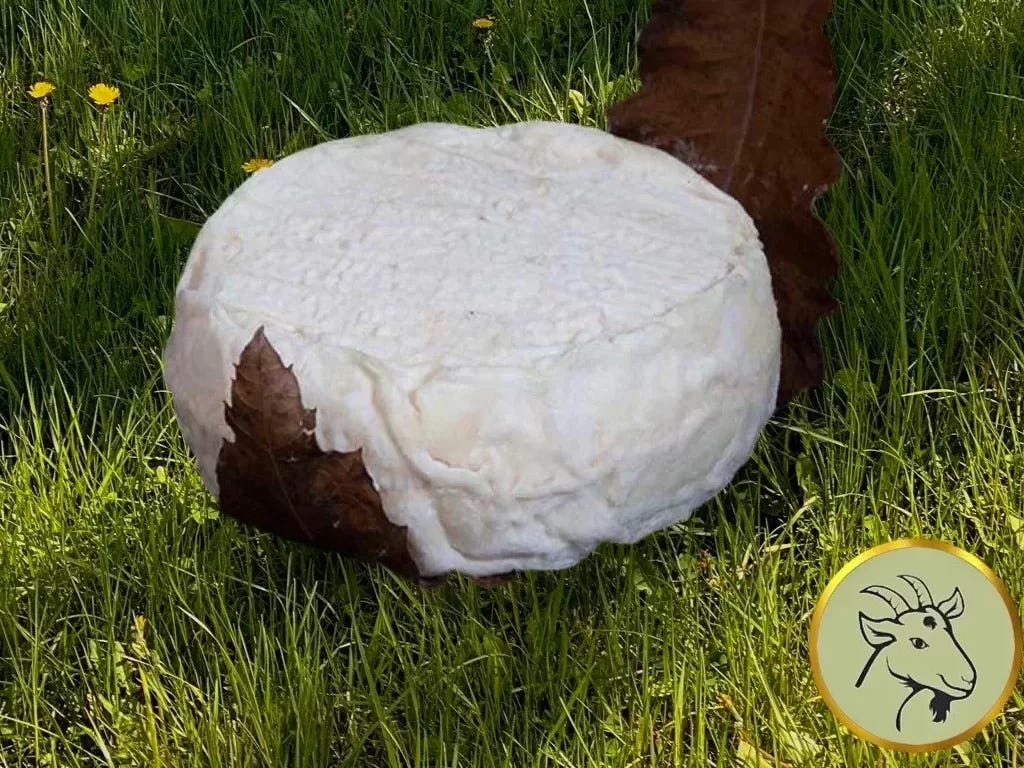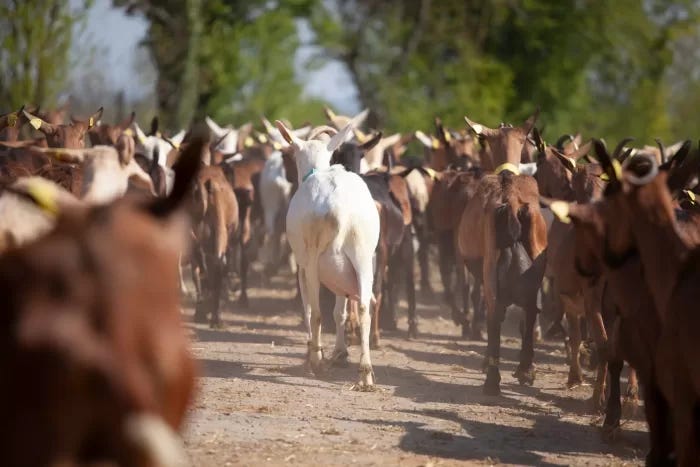14.07 - Mothais-sur-Feuille: The wonder of Fromage – unveiling one French cheese at a time
IMMERSION: A deep dive into fromage featuring Mothais-sur-Feuille, a goat cheese from Deux-Sèvres & Vienne, near La Rochelle. Francophiles and cheese connoisseurs/ses are you prepared for this?
This is your FREE le Bulletin, the weekly newsletter of MyFrenchLife Magazine
Bonjour, I can’t tell you how happy I am to count you as a reader of le Bulletin. This is a long post, so if you’re reading this as an email, then please press ‘download entire message’ in the email or the three dots at the base […] as it may be truncated Or, you can read the post directly here.
Merci. Judy - 24.2.24
1. Featured Contributor this week: Emily Monaco
Emily describes herself: “Born and raised in New York, I fell in love with France young and have been based in Paris for over 15 years. I am a professional freelance writer, tour guide, and cheese connoisseuse, as well as the host of Navigating the French and co-host of The Terroir Podcast. Follow me on Instagram and sign up for my newsletter for my favorite bites and more from Paris.”
2. Mothais-sur-Feuille: The wonder of Fromage – by Emily Monaco
France is currently home to 46 AOP cheeses, but soon it may count 47.
Producers of Mothais-sur-Feuille, a goat cheese hailing from Poitou-Charentes, aka the French cradle of chèvre, have applied for their very own appellation. If all goes well, France will welcome its newest AOP cheese in early March, just in time for goat cheese season to commence.
What is Mothais-sur-Feuille?
Mothais-sur-Feuille is a goat cheese produced in the Deux-Sèvres and the Vienne, not far from La Rochelle.
Named after the Deux-Sèvres village of La Mothe-Saint-Héray, Mothais-sur-Feuille stands out from its fellow chèvres in a number of ways. It boasts a wrinkled white rind often covered in flavorful blue and white molds. Its 200-gram weight makes this disc of cheese far larger than most: Selles-sur-Cher, similar in shape, weighs just 150 grams.
Perhaps its biggest distinguishing characteristic is the leaf upon which it is placed at just 48 hours of age –and this for up to twelve days. This leaf, which can hail from the sycamore or plane tree but is most often local chestnut, certainly makes Mothais-sur-Feuille recognizable.
But for Delphine Georgelet, a third-generation cheesemaker in Villemain, it’s far more than that. A nod to history as well as an essential contributor to the cheese’s quality, the feuille evoked in the cheese’s title is non-negotiable.
We’ve noticed that this leaf when it’s added after two days, helps retain some of the moisture of the cheese,” she says. “And at the same time, the cheese’s moisture soaks up a bit of flavor from the leaf, which will give the cheese its character.”
Mothais-sur-Feuille is indeed moister than most, a sought-after characteristic that begins with an unusually slow curd formation. Rennet-fermented goat cheeses may form curds in just two hours; lactic-fermented goat cheeses are typically left curdle for 24. But Georgelet, for example, waits a whopping 48 hours, which ages the curd to lend even more flavor and moisture.
Once unmolded, Mothais-sur-Feuille is traditionally aged in cellars with unusually high humidity, which means it slowly but surely develops a meltingly soft texture: light and marshmallowy when it’s young and creamy and soft as it ages. This tenderness is only highlighted by the presence of the leaf, according to Stéphane Dos Santos of the Fromagerie des Gors in Melle, who notes that the cheese remains “a bit runnier on the leaf side.”
It’s going to preserve the cheese,” he says. “This leaf is going to be a bit of a hydrometric regulator.” The leaf doesn’t just contribute to the texture of Mothais-sur-Feuille; it’s also essential in cultivating its unique flavor, allowing certain bacteria to flourish on the rind, which in turn help the cheese develop more complexity.
Indeed, a good Mothais-sur-Feuille has delicate earthy, almost ‘woodsy’ aromas that only intensify with time.
You need to wait til it’s aged a bit,” he says, “but beginning at three weeks, a month, Mothais really takes on a very characteristic flavor thanks to that leaf.” Georgelet agrees.
There’s a personality to it that I think… no, I don’t think. It’s the leaf that gives it that character,” she says.
What Makes a Good Mothais Great?
Mothais-sur-Feuille’s bid for AOP protection has only recently become newsworthy, but in reality, the news is 25 years in the making.
There are so many products in France that have characteristics that make them stand out,” says Dos Santos. “But at a certain point, you say to yourself… well, let’s do this.”
The first step, he says, is to rally the troops, as it were: Producers of the product in question must agree that it’s worth establishing the historic precedent and technical norms that will if all goes well, comprise the cahier des charges, the official set of rules and standards to which all producers who hope to maintain the AOP must hew. This multi-page document encompasses everything from what the animals eat to where they can graze to methods of cheese production. Once the rules have been established, it all must be run past several commissions before the AOP is finally established.
In the case of Mothais-sur-Feuille, a few distinctive characteristics may end up in the final charter.
The Poitevine goat is a robust, endemic breed that has nevertheless been supplanted on many farms by more productive Alpines and Saanens. The cahier des charges for Sainte-Maure-de-Touraine produced not far from Tours, allows producers to choose to raise any of these three breeds or a combination; such norms might be stricter or looser in the case of Mothais-sur-Feuille.
There may also be regulations regarding seasonality, as there are for the Auvergne’s Salers, which can only be produced from mid-April to mid-November. In the case of goat cheese, this is particularly apt, as goats are notoriously difficult to milk out of season unless one opts for tricks like hormone supplementation or artificial lighting to help get a doe to come into heat in winter. Georgelet eschews these methods, opting to produce Mothais only in spring and summer, relying in winter on other long-aged cheeses like tome de chèvre, which remains delicious at up to six months of age.
There may also be rules linked to the diet of the goats whose milk will be made into Mothais. The goats’ diet, after all, contributes an enormous amount to the flavor of the cheese, according to Dos Santos, who notes that at Fromagerie des Gors, all the milk comes from two local producers who grass-feed their goats.
It really lends much more subtle flavors,” he says, “because in springtime they eat flowers, things like that, and you find it immediately in the milk.”
And then, of course, there are the leaves. The Mothais charter may take a page out of the cahier des charges for Banon, a Provençal goat cheese wrapped in chestnut leaves that must, by law, be gathered in autumn, when they naturally fall from chestnut trees. At Georgelet’s dairy, they are collected by a local woman who once worked in the fromagerie.
She knows our cheeses well,” Georgelet says. “And she gathers our chestnut leaves for us every year.”
How to Enjoy Mothais-sur-Feuille
Mothais-sur-Feuille can be consumed anywhere from eight days to six weeks of age, though it will change greatly in flavor depending on the affinage you choose, according to Dos Santos.
If you like, it can be a bit fresh, with nice ‘goaty’ notes,” he says, noting that as time goes on, “it will become much stronger, with a more pronounced flavor. So you can have two products that are really quite different from one another.” His personal preference is to enjoy it “fairly aged” – at about four to six weeks. “That’s when it develops all of its character,” he says.
Georgelet too prefers a six-week-old Mothais, noting that at this point, it takes on its ideal, slightly creamy texture and develops its fullest, richest flavor. Her ideal Mothais is perfectly paired with local wine, in particular the natural Cheverny from Hervé Villemade.
It’s a pairing that’s really quite cool,” she says.
** Merci Emily - You can access all of Emily’s articles here.←
Have you tried Mothais-sur-Feuille? What is your opinion, how would you compare it with other chèvre?
3. MyFrenchLife™ French Book Club #bookclub
Book Club Zoom EVENT #1 is about to start!
Event #2 is also on Saturday 24 February.
Note the EVENT TIME for your time zone if you’ve already registered.
The Zoom link is essential for event access. Registrations have closed, unfortunately.
EVENT #1 - EUROPE & AUSTRALIA
UK/ Ireland:- Saturday 24 February - 9am
France: - Saturday - 24 February - 10am
Australia - East Coast - Saturday 24 February - 8pm
EVENT #2 - USA, EUROPE, AUSTRALIA
USA:
- PST - Saturday 24 February - 12 noon
- MST - Saturday 24 February - 1pm
- CST - Saturday 24 February - 2pm
- EST - Saturday 24 February - 3pm
France: - Saturday 24 February - 9pm
Australia: - East Coast - SUNDAY 25 February - 7am
b) Discover our 2024 reading list
If you’d like to join our book club and read with us next time. You’ll find all the information you’ll need here.
In this article, you’ll discover not only the first novels on the 2024 reading list but also the list that’s currently ‘under consideration’. Here you can discover that article.
Next book:
ANNOUNCEMENTS about the reading period for the next book ‘The Postcard’ by Anne Berest, translated by Tina Kover <- Original title ‘La Carte Postale’ will be made mid-March - watch this space. If you’d like to get ahead of the game you could order your book now in French or English - the choice is yours.
4. Writing in Paris
I know that many dream of writing in Paris… So here is something a little special. Paris Writers Workshop, yes, that one, the one with the great reputation. Well, it will be held on 2-7 June before the Olympics! Importantly, the ‘early bird registration’ with a health discount is available now. They’ll also kindly help you with pointers for accommodation with a sensible warning to get in asap to secure reasonably priced digs.
5. Merci mille fois - event fun
As you’re reading this I’ll be amid the book club event/s at the culmination of the reading of our first 2024 book. I enjoy these lively events and connecting with Francophile readers across the globe. This time across 6 timezones. I invite you to join us next time.
If you’re a new subscriber to le Bulletin, the newsletter of MyFrenchLife Magazine, I’m glad that you found us - you’re very welcome here! And thank you all for providing subscriber support.
Merci
Judy
Here’s how you can stay in touch & personalise your experience:
If you’d like to be sure you GET or NOT GET posts/emails about our French Book Club, you can personalise your account. toggle ON or OFF.
Recently a few random email newsletters were not been sent out. If you feel that you may have missed some you can check & test your account here.
Like this le Bulletin newsletter of MyFrenchLife.org Magazine? Forward it or Share it with a friend. Surprise them and help us grow.
Loved a story? Hated it? Drop me a note or just write to say ‘bonjour’.
Did a friend forward this to you? Sign up to get le Bulletin newsletter weekly.
And… finally, you can immerse yourself in the archive of le Bulletin Newsletter here & the MyFrenchLife Magazine archive of >3000 articles





